Latest News
► Polo Glossary
 Polo Glossary
Polo Glossary
Below are all the polo terms you need to know! Many thanks to HPA (www.hpa-polo.co.uk) for help with the content.
Appealing: Claims by players for a foul generally expressed by the raising of mallets above the head or by a helicoptering motion. Over demonstrative appealing is considered very bad form.
Back shot: Backhand swing, changing the flow of play by sending the ball in the opposite direction.
Ball: White and made of plastic or wood. It weighs four and a half ounces and is three and a half inches in diameter.
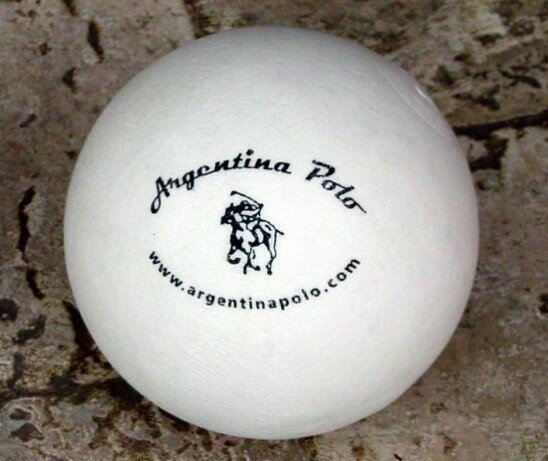
Bell or hooter: This is situated off the side of the field and is rung by the timekeeper to inform umpires when seven minutes of play in a chukka have elapsed.
- Bowl in: When the umpire starts or resumes a polo match by rolling the ball down the center of a lineup of players, same as throw in.
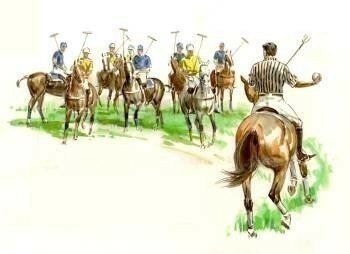
Bump: A player is permitted to ride off another to spoil his shot or to remove him from the play. The angle of contact must be no more than 45 degrees. The faster the pony travels the smaller the angle must be. A good bump can shake discs and dentures loose.
- Check and turn: To slow the pony and turn safely.
Chukka: There are six chukkas (periods) in high handicap matches, each lasting seven minutes plus up to 30 seconds of overtime. If, during the extra 30 seconds, the ball hits the sideboards or goes out of bounds, or if the umpire blows his whistle for a foul, the chukka is over. There is no overtime at the end of the final chukka unless the score is tied. Players return to the field each chukka with a fresh pony. Chukka comes from the Indian word for a circle or round.
Divots: Turf kicked up by a ponies' hooves
Ends: The back lines of a polo pitch. Teams change ends, i.e. switch the halves they defend, each time a goal is scored in order to equalize wind and turf conditions.
Equipment: Hard helmets for players are compulsory. Knee-pads, whips and spurs are optional
Field: A full size polo field is 300 yards by 160 yards, or the area of three soccer pitches. The goal posts, which collapse on severe impact, are set eight yards apart.
- Flagman: An unofficial goal observer appointed to signal by waving a flag over the head if a goal is scored, or under the waist if no goal.
Forehand: The most common shot, used to hit the ball forwards. The Offside forehand is th most powerful shot.

Goal: Any time the ball crosses, at any height, the line between the goal posts, it is considered a goal regardless of who knocks it through, including the pony.
Handicap: All players are rated on a scale of -2 to 10 (the higher the better). Although the word 'goal' is often used after the rating, it bears no relation to the number of goals a player scores in a match, but to his overall playing ability. A player's horsemanship, range of strokes, speed of play, team and game sense are the factors considered in determining his handicap. The team handicap is the sum of its players' handicaps.
In handicap matches of six chukkas, the team with the lower handicap is awarded the difference in goals at the start of the game. For example, a 26-goal team would give two goals start to a 24-goal team.
For matches other than six chukkas, the side with the lower handicap starts with a number of goals start according to the following formula. The difference in the teams handicaps is multiplied by the number of chukkas to be played and then divided by six. Fractions count as half a goal. For example, a 26 goal team would give a 24 goal team 11/2 goals start in a four chukka match.
Hook: Provided the player is on the same side of the opponent's pony as the ball, he may spoil the opponent's shot by putting his stick in the way of the striking player's.
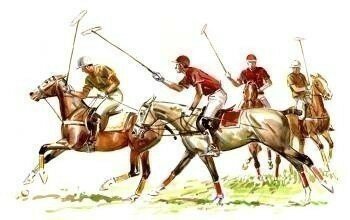
HPA: Hurlingham Polo Association. The governing body of polo in the UK. http://www.hpa-polo.co.uk.
Intervals: Three- minutes long rest periods between chukkas. Half time is five minutes.
Judges: Goal judges are positioned behind each goal to signal whether a goal has been scored. Hard hats are worn for protection. Alo known as flagmen.
Knock-in: Should a team hit the ball across the opponent's backline during an attack, the defending team resumes the game with a free hit from the backline where the ball went over. It is equivalent to a goal kick in soccer.
Leave it: To ride past the ball so that the teammate behind can hit it.
Line of the Ball: 'Crossing the line' is the most frequent foul in polo. The line of the ball, namely the imaginary line along which the ball travels, represents a right of way for the player following nearest that line. There are strict rules governing opponents entry in to the right of way. In the picture below the green line represents the line of the ball, the player on the red line is fouling because they crossed the line.
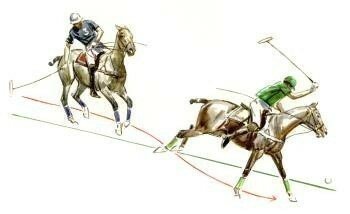
- Made pony: A polo pony that is well trained for polo and has been played for some time.
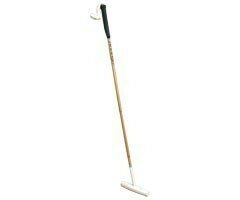
Mallet/Stick: The shaft is usually made from bamboo cane and the head from a hard wood. The wide face of the mallet head is used to strike the ball and not the ends, as in croquet. Polo mallets range in length according, principally, to the height of the pony played, and extend from 48 to 54 inches. - Mallet head: The part of the mallet used to strike the ball, the wide face of the head is used to strike the ball.
Nearside: The left hand side of the pony.
Neckshot: A ball which is hit under the pony's neck.
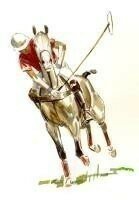
- Officials: Two mounted umpires do most of the officiating, with a referee at midfield having the final say in any dispute between the umpires.
- Offside: The right hand side of the polo pony.
Out-of-bounds: When a ball goes over the sideboards, it is considered out-of- bounds. The umpire throws the ball in between the two teams lined up at the point at which it left the field of play. It is equivalent to a throw-in in soccer.
- Pass: To hit the ball forward or laterally to a teammate.
Penalty: A free hit towards goal is awarded when a foul is committed. The hit is taken from a set distance, dependent on the severity of the offence. Distances are as follows: -
Penalty 1: Automatic goal
 Penalty 2: 30 yards to an open goal
Penalty 2: 30 yards to an open goal
 Penalty 3: 40 yards to an open goal
Penalty 3: 40 yards to an open goal
 Penalty 4: 60 yards to a defended goal
Penalty 4: 60 yards to a defended goal
 Penalty 5: from anywhere on the ground
Penalty 5: from anywhere on the ground
 Penalty 5B: from the centre of the ground
Penalty 5B: from the centre of the groundPonies: Although termed 'ponies' they are in fact horses- i.e., above the 14.2 hands height of a normally defined pony. Most are of the Argentinean Criollo breed or pure or cross thoroughbreds. Their main qualities are speed and stamina; the ability to accelerate, stop and turn quickly; and temperaments that are amenable to the rigors of the game.
There is no height limit for the ponies, although most are between 15 and 15.3 hands. Bandages or leg wraps are used for support and protection. Players admit that the pony can account for as much as 80 per cent of their overall performance. - Pony goal: When a polo pony causes the ball to go through the goal posts.
Positions: Each of the four team members play a distinctly different position. Since polo is such a fluid game, players must momentarily change position, but will try to return to their original assignment. -
No. 1: essentially a goal striker.
 No. 2: also a forward, but plays harder, especially on defense.
No. 2: also a forward, but plays harder, especially on defense.
 No. 3: the pivotal player between offence and defense who tries to turn all plays to offence. He is usually the highest rated player on the team.
No. 3: the pivotal player between offence and defense who tries to turn all plays to offence. He is usually the highest rated player on the team.
 No. 4: or back, is the most defensive player whose primary responsibility is to protect the goal area.
No. 4: or back, is the most defensive player whose primary responsibility is to protect the goal area.Ride-off: Two riders may make contact and push each other off the line to prevent the other from striking the ball. It is primarily intended for the ponies to do the pushing, but a player is allowed to use his body, but not his elbows.
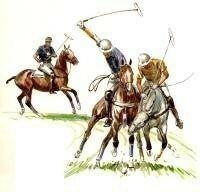

Safety: Also known as a Penalty 6, a safety is awarded when a defending player hits the ball over his own backline, the shot is taken 60 yards out from the backline, opposite the point at which the ball went over.
It is equivalent to a corner in soccer and no defender can be nearer than 30 yards from the ball when it is played.
Sideboards: These are nine to eleven inch high vertical boards along the sidelines only. Such sideboards are optional.
Stick: The polo mallet.
Stick and ball: Personal practice time.
Sudden death: Overtime play when the score is tied at the end of the last regular chukker, the first team to score wins.
Swing: Hitting at the ball with the mallet using one of four basic shots: forehand, backhand, neck, and tail. - Tack: All the equipment used on a pony.
Tailshots: Hitting the ball behind and under the pony's rump.
Thirdman: The referee sitting at the sidelines who will arbitrate if the two mounted umpires on the field are unable to agree a foul.
Time-Out: Called by an umpire when a foul is committed, an accident occurs or at his discretion. A player may call time-out if he has broken a key piece of tack or is injured. Time-out is not permitted for changing ponies or for replacing a broken mallet, although a player may do so at any time.
Treading-In: The replacement at half time of divots of turf. This is the duty of all spectators.
- Turn: To backhand hit the ball away from the goal being defended.
Umpires: Two mounted umpires (one for each side of the field) who regulate the game. They usually wear striped shirts.

VIP: The team patron.
Wellingtons: Rubber boots ideal for treading-in in wet weather. Usually green.
- Wraps: The protective bandages the polo ponies wear on their legs

Xtra -Time: In the event of a tied score at the end of the final chukka, there will be a five minute break to allow the players to catch their breath and change to a fresh mount before beginning a sudden-death chukka. The first team to score wins. In extra time, the goal area is usually widened by moving the goal posts an extra 8 yards apart.
Zone (safety): The area around the pitch that is out of bounds for the spectators during play.






